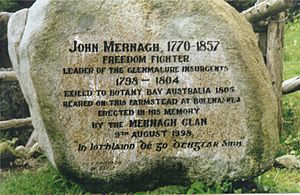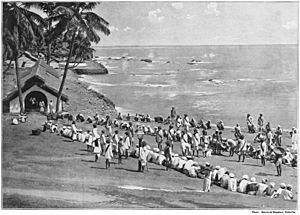Penal colony facts for kids
A penal colony was a special kind of settlement. It was used to hold prisoners far away from their homes. These prisoners were often forced to work for the government. Penal colonies were much larger than regular prison farms.
One famous penal colony was Devil's Island in French Guiana. The British Empire used its lands in North America as penal colonies for over 150 years. Later, the first British settlements in Australia also began as penal colonies.
Contents
Life in a Penal Colony
Life in a penal colony was usually very difficult. Prisoners often faced harsh physical punishment. Some were sentenced to stay there for their entire lives. Many prisoners died from hunger, sickness, or working too hard. Others died trying to escape.
Penal colonies were often set up in faraway places. This made it very hard for prisoners to escape or return home. These places were usually unsettled lands. They were areas where few people wanted to live or work. The prisoners' unpaid work helped governments develop new areas. This saved a lot of money.
Penal Colonies of the British Empire

The British first used parts of North America as a penal colony. Convicts were sent there by private companies. They were then sold to plantation owners. About 50,000 British convicts were sent to colonial America. This was about one-fourth of all British settlers in the 1700s.
After the American Revolutionary War, Britain needed new places for its prisoners. They then started large penal colonies in Sydney, Norfolk Island, Van Diemen's Land, and Western Australia.
In colonial India, the British also created several penal colonies. Two well-known ones were on the Andaman Islands and at Hijli Detention Camp. In the early days, Singapore also received Indian convicts. Their job was to clear jungles and build public works.
French Penal Colonies
France also sent criminals to tropical penal colonies. In the early 1700s, they sent prisoners to Louisiana. Devil's Island in French Guiana was used from 1852 to 1939. It held people like forgers and other criminals.
New Caledonia and its Isle of Pines in the South Sea also received prisoners. These included political rebels and convicted criminals. This happened between the 1860s and 1897.
Penal Colonies in the Americas
Many countries in the Americas also used penal colonies:
- Brazil had a prison on the island of Fernando de Noronha. It was active from 1938 to 1945.
- Colombia used Gorgona Island for a high-security prison. This was from the 1950s until 1984. Escaping was hard due to venomous snakes and sharks.
- Cuba has Guantanamo Bay detention camp. The United States uses it as a penal colony.
- Mexico used Isla María Madre (in the Marías Islands) as a penal colony. It closed on February 18, 2019. It is now a cultural center.
- Chile used Fuerte Bulnes and Punta Arenas on the Strait of Magellan. These were penal colonies from 1844 to 1852.
- Ecuador used two islands in the Galápagos archipelago. These were San Cristóbal (1869–1904) and Isabela Island (1945–1959).
- Paraguay had the penal colony of Tevego. It was opened in 1813 for minor criminals.
- Argentina had a penal colony in Ushuaia, Tierra del Fuego. It was active from 1902 to 1947.
- Spanish Valdivia in Chile used convicts to build the Valdivian Fort System. Many of these convicts were Afro-Peruvians.
Other Penal Colonies Around the World
Penal colonies were used in many other parts of the world:
- After Alexander the Great's conquests, the Greco-Bactrian Kingdom (modern Afghanistan/Pakistan) was used as a penal colony.
- The Meiji Government used Abashiri Prison in Hokkaido as a penal colony in 1890. It became a regular jail in 1894.
- The Qing Empire of China used Jilin and Xinjiang as penal colonies.
- Imperial Russia used Siberia and the Russian Far East for penal colonies (katorga). These held criminals and people who disagreed with the government. The Soviet Gulag system also used forced labor.
- The Kingdom of Hawaii used Kahoolawe as a men's penal colony around 1830.
- Boven Digoel in Papua was a penal colony for revolutionaries under Dutch rule.
- Buru Island in Indonesia held political prisoners during the New Order era.
- Apartheid South Africa used Robben Island for anti-apartheid activists.
- The Netherlands had a penal colony in Veenhuizen. It was in a remote area of peat and marshland.
- Some sources describe Nazi-era forced-labor camps (Arbeitslager) as penal colonies.
- North Korea has a penal system that includes prison labor camps.
- Tarrafal was a Portuguese penal colony in the Cape Verde Islands. It held opponents of the government.
- Spain used Fernando Po in Equatorial Guinea as a penal colony.
- Taiwan had a penal colony at Green Island during the White Terror (1949–1987). Today, it is a tourist spot.
- Côn Đảo Island in Vietnam was used as a penal colony by French colonists and later by the Republic of Vietnam.
- The Ottoman Empire used Fezzan as a penal colony. It was the most remote province from the capital, Istanbul.
- The Philippines has penal colonies like Iwahig Prison and Penal Farm and Davao Prison and Penal Farm.
Related pages
See also
 In Spanish: Colonia penal para niños
In Spanish: Colonia penal para niños



